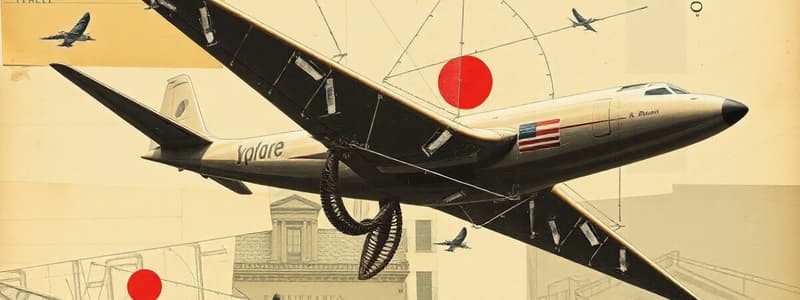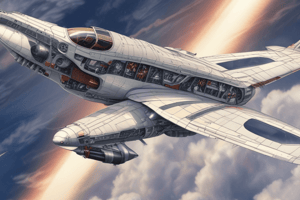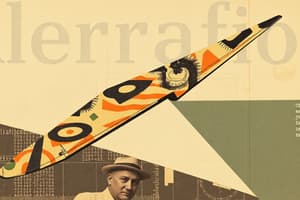Podcast
Questions and Answers
What is the primary purpose of channeling hot air from an engine through the leading edge of an aircraft wing?
What is the primary purpose of channeling hot air from an engine through the leading edge of an aircraft wing?
- To increase wing strength
- To improve aerodynamic performance
- To enhance fuel efficiency
- To prevent ice formation (correct)
How are the ribs of a wing typically reinforced to counteract lateral weakness?
How are the ribs of a wing typically reinforced to counteract lateral weakness?
- By adding additional wing spars
- Employing drag wires
- Incorporating solid metal ribs
- Using tapes woven above and below rib sections (correct)
In a stressed-skin design, how does the wing skin contribute to the aircraft's structural integrity?
In a stressed-skin design, how does the wing skin contribute to the aircraft's structural integrity?
- It serves only as a cover for the wing ribs
- It redistributes the load among the spars and ribs (correct)
- It absorbs shock loads during landing
- It acts as the primary load-bearing component
What is the function of a louver located at the wing tip?
What is the function of a louver located at the wing tip?
Which design method allows for storing fuel inside the wing structure?
Which design method allows for storing fuel inside the wing structure?
What ensures the stiffness of the wing skin in a structure that requires it to share some of the load?
What ensures the stiffness of the wing skin in a structure that requires it to share some of the load?
What type of design is characterized by having the skin share flight and ground loads with the ribs and spars?
What type of design is characterized by having the skin share flight and ground loads with the ribs and spars?
In a box beam structural design for aircraft wings, what is a key benefit?
In a box beam structural design for aircraft wings, what is a key benefit?
What is the primary function of nacelles in aircraft?
What is the primary function of nacelles in aircraft?
Which material is commonly used for the core of honeycomb structures in aircraft?
Which material is commonly used for the core of honeycomb structures in aircraft?
How does the skin of an aircraft wing contribute to its structural integrity?
How does the skin of an aircraft wing contribute to its structural integrity?
Which of the following statements is true about honeycomb structured wing panels?
Which of the following statements is true about honeycomb structured wing panels?
What type of structure do honeycomb panels utilize?
What type of structure do honeycomb panels utilize?
What role does the outer skin of a honeycomb structure serve?
What role does the outer skin of a honeycomb structure serve?
In multiengine aircraft, where are engine nacelles typically located?
In multiengine aircraft, where are engine nacelles typically located?
What is the primary function of tapered core honeycomb panels in aircraft?
What is the primary function of tapered core honeycomb panels in aircraft?
Which element describes the area where landing gear is stored when retracted?
Which element describes the area where landing gear is stored when retracted?
What is one advantage of using honeycomb structures in aircraft construction?
What is one advantage of using honeycomb structures in aircraft construction?
What typically comprises the framework of a nacelle?
What typically comprises the framework of a nacelle?
What material is the firewall of a nacelle primarily constructed from?
What material is the firewall of a nacelle primarily constructed from?
Which type of steel is commonly used for engine mounts in larger aircraft?
Which type of steel is commonly used for engine mounts in larger aircraft?
How are the exterior skins of nacelles typically secured to the framework?
How are the exterior skins of nacelles typically secured to the framework?
What distinguishes cowling from the skin of a nacelle?
What distinguishes cowling from the skin of a nacelle?
In high-performance aircraft, what is the purpose of retracting the landing gear?
In high-performance aircraft, what is the purpose of retracting the landing gear?
What distinguishes the construction of the cone from that of the fuselage?
What distinguishes the construction of the cone from that of the fuselage?
Which of the following are considered movable surfaces in the empennage?
Which of the following are considered movable surfaces in the empennage?
How do fixed surfaces like the horizontal and vertical stabilizers function?
How do fixed surfaces like the horizontal and vertical stabilizers function?
What is the primary function of the spar in the aircraft stabilizers?
What is the primary function of the spar in the aircraft stabilizers?
Which of the following statements about ailerons is correct?
Which of the following statements about ailerons is correct?
What type of control surfaces are ailerons categorized as?
What type of control surfaces are ailerons categorized as?
Which of the following best describes the role of movable control surfaces?
Which of the following best describes the role of movable control surfaces?
What is one major difference between primary and secondary flight control surfaces?
What is one major difference between primary and secondary flight control surfaces?
What is the primary function of the rudder in an aircraft?
What is the primary function of the rudder in an aircraft?
Which construction feature is common to the primary control surfaces of both light and heavy aircraft?
Which construction feature is common to the primary control surfaces of both light and heavy aircraft?
How do control surfaces affect the aircraft's movement around the three axes of flight?
How do control surfaces affect the aircraft's movement around the three axes of flight?
What material is frequently used for the structure of primary control surfaces on light aircraft?
What material is frequently used for the structure of primary control surfaces on light aircraft?
What role do lightening holes play in the construction of aircraft components?
What role do lightening holes play in the construction of aircraft components?
In the context of an aircraft's elevators, which axis of movement do they primarily control?
In the context of an aircraft's elevators, which axis of movement do they primarily control?
What construction advantage do composite materials offer for primary control surfaces?
What construction advantage do composite materials offer for primary control surfaces?
What is the main structural component typically found in the primary control surfaces of an aluminum light aircraft?
What is the main structural component typically found in the primary control surfaces of an aluminum light aircraft?
Study Notes
Wing Design
- To prevent ice formation on aircraft wings, hot air from the engine is channeled through leading edge of the wing from root to tip.
- Stressed-skin design: Wing skin shares some of the load with spars and ribs, increasing strength and reducing weight.
- Wet wing design: Fuel is stored directly inside the stressed-skin wing structure.
- Honeycomb Panel Design: Honeycomb structured wing panels are lightweight and strong. They are often used as skin on stressed-skin wings and in other areas of the aircraft, such as floor panels and control surfaces.
- Wing tip: A wing tip louver allows warm air to be exhausted overboard.
Nacelle Design
- Nacelles house engines and engine components.
- Round or elliptical profile: Reduces aerodynamic drag.
- Multiengine aircraft: Nacelles are built into the wings or attached to the fuselage at the empennage.
- Wheel well: Retractible landing gear is housed here.
- Firewall: Isolates the engine compartment from the rest of the aircraft.
Empennage Design
- Empennage is the tail section of the aircraft.
- Tail cone: The fuselage terminates at the tail cone.
- Components:
- Horizontal stabilizer: Helps stabilize the aircraft.
- Vertical stabilizer: Helps stabilize the aircraft.
- Rudder: Located at the aft edge of the vertical stabilizer.
- Elevator: Located at the aft edge of the horizontal stabilizer.
Flight Control Surfaces
- Primary flight control surfaces:
- Ailerons: Control roll (rotation around the longitudinal axis).
- Elevator: Controls pitch (rotation around the lateral axis).
- Rudder: Controls yaw (rotation around the vertical axis).
- Secondary flight control surfaces:
- Used to assist with control.
Aircraft Construction Materials
- Wings: Fabric, wood, aluminum, honeycomb structured panels.
- Nacelles: Sheet aluminum, magnesium alloy, stainless steel, titanium.
- Honeycomb panels: Aluminum core with an outer skin of aluminum, or Arimid® fiber core with coated Phenolic® outer sheets.
- Tail sections: Heavier construction than the tail cone.
Structural Members
- Wings: Spars, ribs, stringers, skin.
- Nacelles: Longerons, stringers, rings, formers, bulkheads.
- Empennage: Spars, ribs, stringers, skin.
- Flight control surfaces: Spars, ribs, stringers, skin.
- Composite Materials: Common in flight control surfaces.
Studying That Suits You
Use AI to generate personalized quizzes and flashcards to suit your learning preferences.
Related Documents
Description
Explore the intricate designs of wings and nacelles in aerospace engineering. This quiz covers features like stressed-skin design, wet wing design, and aerodynamic efficiencies. Test your knowledge on how these components contribute to aircraft performance and safety.




